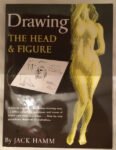And now for something completely different. A book that can't be read. This isn't a…

Expressive Figure Drawing, Bill Buchman – Book Review
And it’s time for another book review, and again it’s a book on figure drawing. After this I really need to do more artwork before reading the two remaining books on my pile. This is a 176-page paperback.
As the title suggests, this book is about figure drawing but, unlike Legaspi and Huston, this is about expressive figure drawing. Expressive figure drawing is different to realistic figure drawing. We can emphasise proportions rather than measuring them, we can leave out arms and heads and let the viewer add them in in themselves (although we might hint at them with a mark of some sort) and we can abstractify the colours and shapes. All as long as the finished result has some mood or energy to it. This is my sort of painting!
As I expect from a book like this, the most interesting stuff was in the middle, bookended by chapters that were full of encouragement and passion, trying to rack up the excitement. The middle 90 pages were where the action was though, with separate chapters on gesture, mass, line, structure, shape, volume and colour. These six chapters can all be read in any order because they don’t build on each other: they only concentrate on their own subject. I get the feeling that if I put together a piece using all the information in all six chapters, it would look really good, maybe more realistic than expressive.
Anyway, within each of those chapters, there are some tips but most of the learning comes through Bill’s demonstrations and the examples of Bill’s completed artwork. Some of those artworks are examples of what might come out if we attempt some of the exercises that Bill set throughout the book. I normally hate exercises in books as they tend to not aim towards artworks (so I tend to see them as a waste of paper and paint) but almost all of Bill’s do result in artworks, as evidenced by the examples he shows of completed exercises.
Materials-wise, there’s lots to learn here whatever materials you use. There are lots of examples where Bill uses pastels, chalks or crayons because he likes to use them on their side and twist them around to get outlines with varying thickness. But anybody that thinks there are no lessons in this that can be applied to other media is lacking in imagination. It does tempt me into trying out these other media though, mind you.
All in all, good book. I’d recommend buying and reading the Chris Legaspi book before reading this one, just because you need to understand the rules before you break them. The best bit about this book is the artwork inside it: this is one of those books that inspires the reader and where you need to keep looking back at it every now and then to refresh that inspiration. It’s not a book where the learning can all easily be converted to notes. I originally gave this one three palettes but am upgrading it to four. I just find t( artwork in it so inspiring. This book feels like a license to go out there and break the rules. But you do need to learn the basics first via Legaspi or Huston.
You can find this book and more reviews of it at Amazon UK here.As an Amazon Associate, I earn commission from qualifying purchases but this costs absolutely nothing extra to you.








Leave a Reply